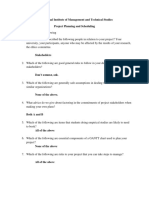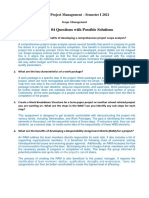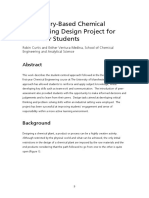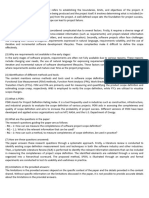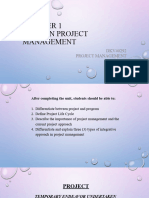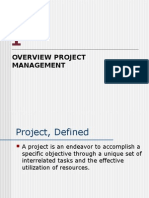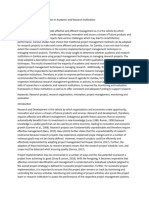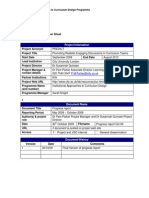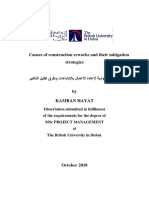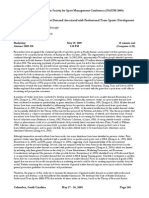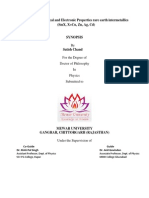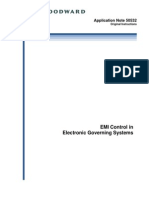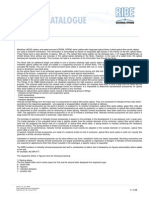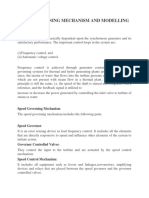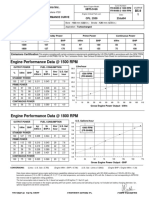Implementation of A Dossier-Based Submission Process in A Senior Design Project Course
Implementation of A Dossier-Based Submission Process in A Senior Design Project Course
Uploaded by
rgovindan123Copyright:
Available Formats
Implementation of A Dossier-Based Submission Process in A Senior Design Project Course
Implementation of A Dossier-Based Submission Process in A Senior Design Project Course
Uploaded by
rgovindan123Original Title
Copyright
Available Formats
Share this document
Did you find this document useful?
Is this content inappropriate?
Copyright:
Available Formats
Implementation of A Dossier-Based Submission Process in A Senior Design Project Course
Implementation of A Dossier-Based Submission Process in A Senior Design Project Course
Uploaded by
rgovindan123Copyright:
Available Formats
IMPLEMENTATION OF A DOSSIER-BASED SUBMISSION PROCESS IN A SENIOR DESIGN PROJECT
COURSE
Hodgson, A J; Van der Loos, M; Fengler, M; Cramond, P; Winkelman P and Khorasany R
Department of Mechanical Engineering, University of British Columbia, Vancouver, BC, Canada
ahodgson@mech.ubc.ca
INTRODUCTION
At UBC, students taking the senior design project course associated
with mechanical engineering have traditionally been required to submit a
series of six reports at roughly monthly intervals. The primary purposes
of these reports are (1) to give the students practice in the professional
discipline of properly documenting their work, (2) communicating with
the other stakeholders in the project, and (3) enabling their supervisors
to assess the soundness of their design.
Historically, a number of students have reported feeling that these
documentation requirements are onerous and slow their progress, and/or
that the standard report sequence or the deadlines do not suit their
project; in such cases, students may feel pressured to do a particular
design task just because it is required for the report, rather than because
they actually believed it would help move their project forward.
To mitigate these problems, we implemented a new dossier-based
documentation scheme. Instead of formal reports, we asked the students
to build a design dossier documenting key elements of their design.
Students could adjust the weighting of different dossier elements to
better reflect their specific design project and could choose (as part of
their time management plan) when each element would be handed in. In
addition, we simplified the formatting requirements to allow students to
focus on presenting core information (e.g., substituting forms when
possible). The purpose of this paper is to present our initial experience
with using this new format.
CURRENT REPORTING APPROACH
Approximately ten years ago, the UBC Mechanical Engineering
department changed its approach to running our capstone design course.
Previously, our projects had been supervised by volunteer instructors,
but this resulted in inequitable supervision loads and dramatically
different expectations from project to project. By bringing all projects
under a common administrative framework, we were able to have
instructors and professors specifically assigned to this course (and
receive teaching credit) and to harmonize our expectations and standards
across instructors. In addition, we established the expectation that
virtually all projects would be done on behalf of an external client and
that a design-build-test-redesign cycle was to be a standard element.
Central to this change was a standardization of the reporting
expectations. Students were required to submit approximately one
significant report per month (six reports in all). These included: (1) a
project proposal presenting the user assessment process, the project
requirements and evaluation criteria, and the work plan, (2) a conceptual
alternatives report presenting a function structure decomposition, a range
of alternative solutions and the initial concept selection results, (3) a
critical function prototype report presenting the results of early
prototyping work aimed at proving the feasibility of the most promising
approach(es) to the key function which needs to be implemented, (4) a
technical analysis report focusing on optimizing the performance of the
chosen concept, (5) a detailed design report, and (6) a final
documentation package for the client presenting the results of the user
evaluations, any verification or validation studies and any user
documentation.
While our revised course was generally well-accepted by students
and clients, students consistently expressed frustration with the reporting
format, claiming that the uniform submission schedule across all
projects failed to recognize critical differences in emphasis between
projects and the formal nature of the reports consumed too much time
and diverted them from making progress on what they saw as the real
purpose of the project, which in their view was to build something.
Although the instructors felt that, by and large, there was sufficient
flexibility in what was requested of different teams to accommodate
inter-team differences, the formal nature of the reports came to be
perceived as a consistent irritant and impediment to students buying in to
some of the broader goals of the course. This past year, therefore, we
decided to adopt a different approach.
DOSSIER-BASED REPORTING
In September 2010, we introduced a new reporting process, which
we referred to as Dossier-Based Submissions (DBS). The process was
modeled on the design dossier which is frequently used in industries
operating under the sorts of design control approaches normally
implemented as part of ISO 9000-type quality control processes. In such
industries, all design and development activities related to a particular
product are documented by adding elements to a design file. Such
design files contain numerous elements ranging from formal documents
such as proposals to briefer elements such as memos reporting results of
interviews or short test reports, along with routine documentation such
as engineering change orders and weekly progress reports.
We therefore completely restructured our documentation
requirements to emulate this approach. We told the students that they
would be responsible for determining both what elements they would
need to hand in and what schedule they follow in submitting their work.
To assist them in managing their time, and to prevent them from handing
in a mass of work at the last minute, we told them that they needed to
present a work plan broken down by the number of person-hours that
they planned to invest in the various phases of the project (a standard 4-
person team was expected to put in 8h/week/person for 28 weeks, or 224
person-hours each, or 900 hours total per team). We asked them to
organize the year into 12 phases, each lasting approximately two weeks
1
(though this was variable), plus a 13
th
Final Submission phase. Within
each phase, we asked them to break down their work to the point where
they could identify both what design activities they planned to spend
their time on and what documentation they intended to submit, and we
encouraged them each week to ensure that they had time-management
plans in place for roughly the next three phases (month and a half).
In the marking scheme, each team determined how much weight
they planned to give to each phase. The weighting was based explicitly
on how much time they planned to spend in each phase, and the volume
of documentation was not tightly linked to the time spent. For example,
during the prototype construction phase, the reports were relatively
short, consisting mainly of photographs of key points in the building and
assembly process. In contrast, a literature review and patent assessment
process typically produced considerable documentation.
We encouraged the students to consider the need for each piece of
documentation to be based on the need to communicate to their
supervisors what they had been spending their time on and what the
significance of what theyd found was for decision-making in their
design project. That is, we emphasized that the documentation was not
needed simply for the sake of documentation, but to help them have an
intelligent and focused conversation with their supervisors. The briefest
template we presented for most documentation was a simple memo with
four sections: 1. Why? 2. How? 3. What? and 4. So What?
DISCUSSION
Although we dont have firm statistics to compare directly our
previous formal reporting approach to our new dossier-based approach,
our sense is that by and large students appreciate the new freedom and
flexibility. Some didnt initially understand how much flexibility they
had, and others failed to recognize the importance of producing standard
forms of evidence of design activities theyd undertaken. In response to
this, we have begun work on designing new rubrics to help students
better understand our expectations. Anecdotally, we have observed that
many students rapidly got into the habit of writing summary memos
when they had client interviews or conducted tests, and we instructors
generally felt more on top of our groups progress than we have in
previous years, so we intend to continue using this dossier approach.
1
These phases included, amongst others, user assessment,
specifications, concept generation and selection, critical function
prototyping, technical assessment, detailed design, prototype
construction, and verification and validation.
REFERENCES
1. Smith PA, Jones GA, Black LP. J Materials 2001;34:545-9.
2. McMaster DS, Robson MA. Science 1992;17:66-73.
3. Brown AL. Engineering 1981;6:93-7.
4. Pope PM et al.. ABC 22
nd
Meeting, 2006.
You might also like
- Ficha Técnica Amulet InnovalityDocument52 pagesFicha Técnica Amulet InnovalityDireccion de Infraestructura77% (13)
- Integrated Project Planning and Construction Based on ResultsFrom EverandIntegrated Project Planning and Construction Based on ResultsNo ratings yet
- Project Estimating and Cost ManagementFrom EverandProject Estimating and Cost ManagementRating: 4.5 out of 5 stars4.5/5 (12)
- Part List HX2T-50NP/D, HX2T - 60NP/DDocument32 pagesPart List HX2T-50NP/D, HX2T - 60NP/Danita shinde100% (3)
- Johnson Pump Horizontal Centrifugal Pump CombiBloc Instruction Manual PDFDocument60 pagesJohnson Pump Horizontal Centrifugal Pump CombiBloc Instruction Manual PDFseloNo ratings yet
- Maintenance Manual Training Presentation - R.ADocument232 pagesMaintenance Manual Training Presentation - R.AYasir Ammar100% (3)
- Revised ASCEPaperon Preparinga Project ManualDocument10 pagesRevised ASCEPaperon Preparinga Project Manualnoahyosef456No ratings yet
- MMS PGDM Project GuidelinesDocument37 pagesMMS PGDM Project GuidelinesShormistha SenNo ratings yet
- Literature Review On Project Scope ManagementDocument4 pagesLiterature Review On Project Scope Managementc5rn3sbr100% (1)
- 1 Guide To Post Occupancy EvaluationDocument33 pages1 Guide To Post Occupancy Evaluationimperialscribd100% (1)
- Project Planing and Scheduling AnswersDocument13 pagesProject Planing and Scheduling AnswersPradeep PooNoorNo ratings yet
- Tutorial 04 Questions With Possible Solutions: IS333: Project Management - Semester I 2021Document2 pagesTutorial 04 Questions With Possible Solutions: IS333: Project Management - Semester I 2021Chand DivneshNo ratings yet
- An Enquiry-Based Chemical Engineering Design Project For First-Year StudentsDocument8 pagesAn Enquiry-Based Chemical Engineering Design Project For First-Year StudentsMuhammad SaeedNo ratings yet
- Assignment (Project Management)Document26 pagesAssignment (Project Management)api-370836964% (14)
- Projectmanagementppt 1 170927111301Document47 pagesProjectmanagementppt 1 170927111301EstebanNo ratings yet
- CW Assessment 1 Project ProposalDocument8 pagesCW Assessment 1 Project Proposalsalmankhalid0011No ratings yet
- Dissertation Progress Report ExampleDocument4 pagesDissertation Progress Report ExamplePsychologyPaperWritingServiceUK100% (1)
- Chapter 04-Project PlanningDocument26 pagesChapter 04-Project Planningeyobirhanu1992No ratings yet
- Tutorial 4 - Harinie - Teddy - PhubDocument2 pagesTutorial 4 - Harinie - Teddy - PhubHarinie SutharsonNo ratings yet
- Module 15Document5 pagesModule 15YahanieNo ratings yet
- Outline and Advice For Crafting An M Eng Project ProposalDocument3 pagesOutline and Advice For Crafting An M Eng Project ProposalDavid Erickton WanjiruNo ratings yet
- Email:: Essay Writing - Online Assignment Help - Homework Help ServiceDocument8 pagesEmail:: Essay Writing - Online Assignment Help - Homework Help ServicejennifersmithsahNo ratings yet
- Assessing Scrum Project Management and Teamwork in Electrical andDocument17 pagesAssessing Scrum Project Management and Teamwork in Electrical andmamegena96No ratings yet
- Annexure CD - 01'Document10 pagesAnnexure CD - 01'Doger DimmerNo ratings yet
- Chapter 1Document29 pagesChapter 1Pait KhayNo ratings yet
- INSDSG Project Management For Instructional DesignersDocument16 pagesINSDSG Project Management For Instructional DesignersApostolos KoutropoulosNo ratings yet
- PROJECT MANAGEMENT CourseDocument15 pagesPROJECT MANAGEMENT CourseAnaz AliNo ratings yet
- Project Management Coursework ExampleDocument5 pagesProject Management Coursework Exampleafiwhhioa100% (2)
- Effective Assessment of Computer ScienceDocument22 pagesEffective Assessment of Computer ScienceRila AristarianaNo ratings yet
- 2001-003-C-01 Framework For Measuring SuccessDocument21 pages2001-003-C-01 Framework For Measuring SuccessironclawNo ratings yet
- Unit 6 Managing A Successful Computing Project - RemoteWorking BRT CampusDocument9 pagesUnit 6 Managing A Successful Computing Project - RemoteWorking BRT CampusAwan AdhikariNo ratings yet
- Comparive Study of Universities CoursesDocument12 pagesComparive Study of Universities CoursesHaytham BarakaNo ratings yet
- Ind - Overview Project ManagementDocument28 pagesInd - Overview Project ManagementariyadiNo ratings yet
- Collaborating With Local Practitioners To Lead A Capstone Civil Engineering Design CourseDocument17 pagesCollaborating With Local Practitioners To Lead A Capstone Civil Engineering Design CourseMervin BiloyNo ratings yet
- Reflection: Improving Research Through Knowledge TransferDocument6 pagesReflection: Improving Research Through Knowledge Transfermaryam-69No ratings yet
- Stepwise Project Planning: Addis Ababa Science and Technology UniversityDocument22 pagesStepwise Project Planning: Addis Ababa Science and Technology Universitysibhat mequanintNo ratings yet
- Lessons Learned Template 2Document12 pagesLessons Learned Template 2Idrees Shah100% (1)
- Aqa 7993 Wre Jun17Document7 pagesAqa 7993 Wre Jun17Megan AlbuquerqueNo ratings yet
- Week 1: Directing and Managing Project ExecutionDocument10 pagesWeek 1: Directing and Managing Project ExecutionAnonymous 4eQB3WZNo ratings yet
- BSSS-Institute of Advanced Studies: Study/Reading Material Course Name: Project ManagementDocument12 pagesBSSS-Institute of Advanced Studies: Study/Reading Material Course Name: Project ManagementmayurqnaNo ratings yet
- LR 1Document9 pagesLR 1Er HarshaNo ratings yet
- Thesis Proposal Civil EngineeringDocument7 pagesThesis Proposal Civil Engineeringhcivczwff100% (2)
- DocumentDocument18 pagesDocumentbiabutt2002No ratings yet
- PREDICT Project Interim Report Oct 09Document8 pagesPREDICT Project Interim Report Oct 09p_m_parkerNo ratings yet
- Assignment 6.1 DetailsDocument3 pagesAssignment 6.1 DetailsAdamNo ratings yet
- INF 172 Syllabus Winter 2017Document9 pagesINF 172 Syllabus Winter 2017Leon HormelNo ratings yet
- AveryB CS4Document2 pagesAveryB CS4Avery BrooksNo ratings yet
- Project AnalysisDocument2 pagesProject AnalysisMd. MubinNo ratings yet
- Causes of Construction Reworks and Their Mitigation StrategiesDocument89 pagesCauses of Construction Reworks and Their Mitigation StrategiesPrince Gerald VargasNo ratings yet
- Inf 325Document12 pagesInf 325Collins (Collo)No ratings yet
- Team Blue Group Assignment Edid 6511-Textbook ReviewDocument13 pagesTeam Blue Group Assignment Edid 6511-Textbook Reviewapi-570826973No ratings yet
- Notes On Capstone Course Design Professional BehaviorsDocument10 pagesNotes On Capstone Course Design Professional Behaviorsnagasaikiran ponnapalliNo ratings yet
- Stepwise Project PlanningDocument8 pagesStepwise Project PlanningDINESH KUMARNo ratings yet
- Lab Manual For SPMDocument8 pagesLab Manual For SPMSimran Kaur100% (1)
- Unit 6 AB Managing A Successful Business Project LatesDocument12 pagesUnit 6 AB Managing A Successful Business Project Latescolinandroidtv2015No ratings yet
- Cambridge International Project QualificationDocument2 pagesCambridge International Project QualificationSara AhmadNo ratings yet
- Chapter 7: The Project Life Cycle (Phases) : PreviousnextDocument7 pagesChapter 7: The Project Life Cycle (Phases) : PreviousnextABM2014No ratings yet
- Btec HNCD Construction EabDocument16 pagesBtec HNCD Construction EabBarry StrongNo ratings yet
- NewSyllabus 1741201842320462Document9 pagesNewSyllabus 1741201842320462Aliya MalhotraNo ratings yet
- OPS 370 Lecture Week 3 - Defining The ProjectDocument37 pagesOPS 370 Lecture Week 3 - Defining The Projecthieu maiNo ratings yet
- 1ProPrac 3 - RSW MT 1.0 - 4ADocument10 pages1ProPrac 3 - RSW MT 1.0 - 4ADhanica MendozaNo ratings yet
- Episode 1 - Sted ReflectionDocument6 pagesEpisode 1 - Sted ReflectionJay Ar AsorNo ratings yet
- Project ManagementDocument12 pagesProject Managementrahulsha1857No ratings yet
- Calculation (Formula) : Current LiabilitiesDocument1 pageCalculation (Formula) : Current Liabilitiesrgovindan123No ratings yet
- Bone Graphic NovelsDocument12 pagesBone Graphic Novelsrgovindan123No ratings yet
- February 2014 Occupancy Publication RevisedDocument3 pagesFebruary 2014 Occupancy Publication Revisedrgovindan123No ratings yet
- Etc Venues 155 Bishopsgate Local HotelsDocument1 pageEtc Venues 155 Bishopsgate Local Hotelsrgovindan123No ratings yet
- Analysys Mason Microsoft Nokia Deal Sept2013 RDMM0Document2 pagesAnalysys Mason Microsoft Nokia Deal Sept2013 RDMM0rgovindan123No ratings yet
- Hotel List 2014Document2 pagesHotel List 2014rgovindan123No ratings yet
- Personal Statement GuideDocument4 pagesPersonal Statement Guidergovindan123No ratings yet
- Cassidy Sept 5 2005 VersionDocument8 pagesCassidy Sept 5 2005 Versionrgovindan123No ratings yet
- Case1 1Document3 pagesCase1 1rgovindan123No ratings yet
- 2009 North American Society For Sport Management Conference (NASSM 2009) Dimensions of General Market Demand Associated With Professional Team Sports: Development of A ScaleDocument2 pages2009 North American Society For Sport Management Conference (NASSM 2009) Dimensions of General Market Demand Associated With Professional Team Sports: Development of A Scalergovindan123No ratings yet
- Li-Wen Hsieh, National Taipei University Tracy L. Wisdom, USA Field HockeyDocument1 pageLi-Wen Hsieh, National Taipei University Tracy L. Wisdom, USA Field Hockeyrgovindan123No ratings yet
- Outline Writing GuideDocument1 pageOutline Writing Guidergovindan123No ratings yet
- A Look at Key Issues and Emerging Solutions: Brand ArchitectureDocument2 pagesA Look at Key Issues and Emerging Solutions: Brand Architecturergovindan123No ratings yet
- The Link Between Standardization/Adaptation of International Marketing Strategy and Company PerformanceDocument12 pagesThe Link Between Standardization/Adaptation of International Marketing Strategy and Company Performancergovindan123No ratings yet
- Cembre C Connector - AKBAR TRADING EST - SAUDI ARABIADocument2 pagesCembre C Connector - AKBAR TRADING EST - SAUDI ARABIAGIBUNo ratings yet
- Pic SyllabusDocument2 pagesPic SyllabusArunaNo ratings yet
- Study of Mechanical and Electronic Properties Rare Earth IntermetallicsDocument11 pagesStudy of Mechanical and Electronic Properties Rare Earth IntermetallicsAnushree AnilNo ratings yet
- PSF 250 PSF 510wDocument24 pagesPSF 250 PSF 510wthindmanmohanNo ratings yet
- Manufecturing of Pump Sets For Agriculture SubmersibleDocument6 pagesManufecturing of Pump Sets For Agriculture Submersiblemohamed shufiyanNo ratings yet
- EMI Governing SystemDocument12 pagesEMI Governing SystemVivek Pawar100% (1)
- Motor Trend Car Road TestsDocument5 pagesMotor Trend Car Road TestsKibrom HaftuNo ratings yet
- RDC 2011 D20 Base Station RepeaterDocument1 pageRDC 2011 D20 Base Station RepeaterStephane KoffiNo ratings yet
- Leak Assessment ProgramDocument3 pagesLeak Assessment ProgramGhulam Khairul IlhamNo ratings yet
- B08 Ovjesna Oprema Za Optiku PDFDocument117 pagesB08 Ovjesna Oprema Za Optiku PDFmilosevicsasa11No ratings yet
- 2007 Semiconductor CatalogDocument162 pages2007 Semiconductor CatalogNconst3No ratings yet
- 1PH8105-1CF02-3LC2 Datasheet enDocument1 page1PH8105-1CF02-3LC2 Datasheet enjunior ginoNo ratings yet
- Sae Spec For Steel Shot & GritDocument3 pagesSae Spec For Steel Shot & Gritsanoopvk100% (1)
- Mvar Cap CurveDocument17 pagesMvar Cap Curvemshireeshareddy100% (4)
- Material List: Submittal No.: Date: Rev. No.Document2 pagesMaterial List: Submittal No.: Date: Rev. No.aliiiiiiiiiiNo ratings yet
- 3 StacksDocument3 pages3 StacksShru SinghNo ratings yet
- Volvo LoaderDocument2 pagesVolvo LoaderIslam HosneyNo ratings yet
- Speed Governing Mechanism and Modelling: GovernorDocument2 pagesSpeed Governing Mechanism and Modelling: GovernorRahul SinghNo ratings yet
- Engine Performance Data at 1500 RPM: B5.9 1 Cummins IncDocument4 pagesEngine Performance Data at 1500 RPM: B5.9 1 Cummins Incmk100% (1)
- Qag13 DS en - DS - enDocument2 pagesQag13 DS en - DS - enricardobarrocaNo ratings yet
- User Manual: Training For Article Genie Software UsersDocument25 pagesUser Manual: Training For Article Genie Software Usersshiro yashaNo ratings yet
- The VultureDocument36 pagesThe Vulturesikproduction100% (2)
- TransistorDocument23 pagesTransistorRonny PrajitnoNo ratings yet
- Isense User GuideDocument39 pagesIsense User GuidedimkolisNo ratings yet
- Mara Alv Sap AbapDocument4 pagesMara Alv Sap AbapsanjudrNo ratings yet
- Binders For Architectural Coatings: Dow Coating MaterialsDocument12 pagesBinders For Architectural Coatings: Dow Coating MaterialsDuodo Nguyen100% (1)










